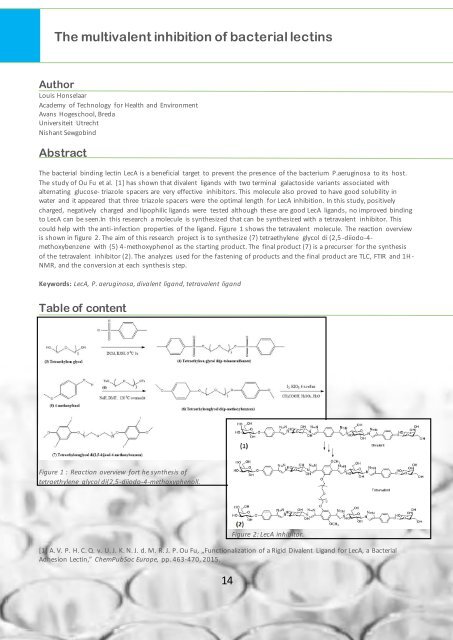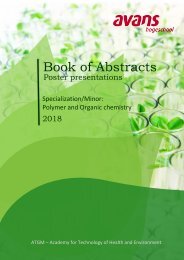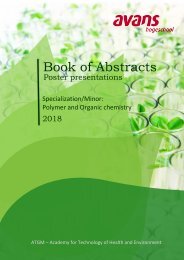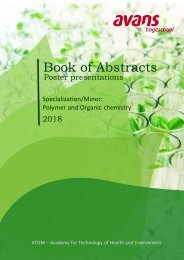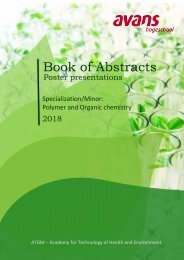Book of abstracts version 5
You also want an ePaper? Increase the reach of your titles
YUMPU automatically turns print PDFs into web optimized ePapers that Google loves.
The multivalent inhibition <strong>of</strong> bacterial lectins<br />
Author<br />
The multivalent inhibition <strong>of</strong> bacterial lectins<br />
Louis Honselaar<br />
Academy <strong>of</strong> Technology for Health and Environment<br />
Avans Hogeschool, Breda<br />
Universiteit Utrecht<br />
Nishant Sewgobind<br />
Abstract<br />
The bacterial binding lectin LecA is a beneficial target to prevent the presence <strong>of</strong> the bacterium P.aeruginosa to its host.<br />
The study <strong>of</strong> Ou Fu et al. [1] has shown that divalent ligands with two terminal galactoside variants associated with<br />
alternating glucose- triazole spacers are very effective inhibitors. This molecule also proved to have good solubility in<br />
water and it appeared that three triazole spacers were the optimal length for LecA inhibition. In this study, positively<br />
charged, negatively charged and lipophilic ligands were tested although these are good LecA ligands, no improved binding<br />
to LecA can be seen.In this research a molecule is synthesized that can be synthesized with a tetravalent inhibitor. This<br />
could help with the anti-infection properties <strong>of</strong> the ligand. Figure 1 shows the tetravalent molecule. The reaction overview<br />
is shown in figure 2. The aim <strong>of</strong> this research project is to synthesize (7) tetraethylene glycol di (2,5 -diiodo-4-<br />
methoxybenzene<br />
The multivalent<br />
with (5) 4-methoxyphenol<br />
inhibition<br />
as the starting<br />
<strong>of</strong><br />
product.<br />
bacterial<br />
The final product<br />
lectins<br />
(7) is a precurser for the synthesis<br />
<strong>of</strong> the tetravalent inhibitor (2). The analyzes used for the fastening <strong>of</strong> products and the final product are TLC, FTIR and 1H -<br />
NMR, and the con<strong>version</strong> at each synthesis step.<br />
Keywords: LecA, P. aeruginosa, divalent ligand, tetravalent ligand<br />
Table <strong>of</strong> content<br />
Figure 1 : Reaction overview fort he synthesis <strong>of</strong><br />
tetraethylene glycol di(2,5-diiodo-4-methoxyphenoll.<br />
[1] A. V. P. H. C. Q. v. U. J. K. N. J. d. M. R. J. P. Ou Fu, „Functionalization <strong>of</strong> a Rigid Divalent Ligand for LecA, a Bacterial<br />
Adhesion Lectin,” ChemPubSoc Europe, pp. 463-470, 2015.<br />
14<br />
Figure 2: LecA inhibitor.


